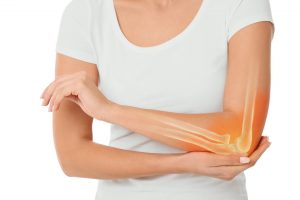Elbow Pain
Pain at the elbow region is a very common issue. There are several reasons to why there are so many people suffering with elbow pain. Most of the time, elbow pain is due to work, sports or accidents.
Reasons for Elbow Pain
Fractures
-
- An elbow fracture can involve any one of the three bones that make up the elbow joint
- Fractures occur with direct trauma to the area such as a direct hit or a fall onto the elbow
Ligament Sprains
-
- Injuries to ligaments can occur with trauma or through over-stretching movements
- The severity of the sprain is determined by a grading system
- 1 – mild stretching or tear of the ligament, with little or no instability at the joint
- 2 – partial tear of the ligament, with some instability in the joint
- 3 – ligament is completely ruptured and there is no stability in the joint
Tendon Strains
-
- Tendon strains can also occur with direct trauma
- However, majority of the time, tendon strains at the elbow occur because the tendon is overloaded
- Overloading can occur with too much weight or too much repetition of an activity
- Tendon strains can also range in severity from mild to severe grades:
- 1 – mild damage to the muscle fibres causing minimal loss of strength and motion
- 2 – moderate damage to the muscle fibres which results in significant loss of strength and motion
- 3 – complete rupture of a muscle or tendon and may require surgery to regain function
Dislocations
-
- Elbow dislocations occur with direct trauma to the area
- The symptoms of an elbow dislocation include:
- Pain
- Swelling
- Bruising
- Deformity
- After a dislocation injury, the elbow is placed in a splint with a sling for a specific time period
- This early immobilization helps the soft tissues and joint recover from the trauma
Arthritis
-
- Changes in the cartilage and underlying bone can occur at any one of the three bones that make up the elbow joint
- For some people arthritis starts with a past trauma to the elbow
- Others develop arthritic changes as part of the normal changes of ageing
- The symptoms of arthritis at the elbow include
- Pain
- Swelling
- Loss of movement
- Locking
- Stiffness
Bursitis
-
- Bursitis occurs when the bursa located at the back of the elbow gets inflamed and fills with increased fluid
- This produces lots of pain, swelling and loss of movement and function
- Inflammation of the bursa can occur due to several reasons
- Direct trauma to the tip of the elbow
- Prolonged pressure on the elbow – for example, leaning on the tip of the elbow on a hard surface for long periods of time
- Infection – for example bacteria may get inside the bursa through a cut in the elbow
Does physiotherapy play a role with elbow pain?
Physiotherapy plays an important role with all of the elbow conditions listed above. Registered Physiotherapists are able to assess the injury or condition and find the limitations and restrictions. Physiotherapists are also able to help patients figure out their goals with their elbow pain. For example, goals may include reducing pain, increase range of motion and strength and returning to exercise.
Once the physiotherapist has assessed the elbow pain condition, the main focus will be on reducing the severity of the symptoms and regain any lost function and abilities. The physiotherapist will use a combination of manual therapy, therapeutic exercises, electrical modalities and education to help with the recovery of the elbow. The time it takes for recovery from elbow pain will depend on the specific condition, the severity, and the individual person. All of our highly experienced physiotherapists at PhysioNow will do their best to make sure that you get the most out of your treatment and that improvement happens in a timely manner.
Don’t let your elbow pain disrupt your life! Call PhysioNow today to book your appointment!




Leave a Reply